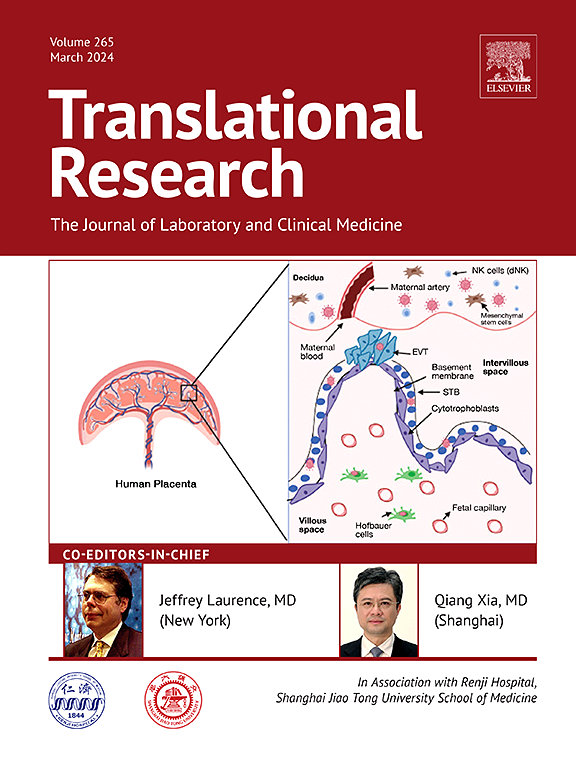腹膜灌洗液循环肿瘤细胞及循环肿瘤DNA预测胃癌异时性腹膜转移的有效性
IF 5.9
2区 医学
Q1 MEDICAL LABORATORY TECHNOLOGY
引用次数: 0
摘要
背景腹膜转移是胃癌(GC)患者死亡的主要原因,强调了早期诊断和高危人群识别的必要性。虽然循环肿瘤DNA(ctDNA)和循环肿瘤细胞(CTC)在血液中的作用已被广泛研究,但它们在腹膜灌洗液(PLF)中的作用仍未被探索。方法入选III期GC患者,收集术前/术后PLF。利用下一代测序(NGS)分析PLF上清中的ctDNA,利用上皮细胞粘附分子(EpCAM)、叶酸受体(FR)和细胞角蛋白(CK)免疫荧光检测颗粒中的CTC。结果sctdna阳性患者腹膜转移风险较高(术前HR: 4.82, 95% CI 1.03 ~ 22.54, p = 0.04;术后HR: 4.83, 95% CI 1.03 ~ 22.54, p = 0.04)。ctc阳性患者的风险也较高(术前HR: 6.76, 95% CI 0.92 ~ 49.74, p = 0.003;术后HR: 7.41, 95% CI 1.67 ~ 32.87, p = 0.02)。与术前相比,术后ctDNA对腹膜转移的预测效果更高,AUC值分别为0.93和0.86。ctDNA/CTC联合阳性提示复发风险最高(术前HR: 8.07, 95% CI 0.96 ~ 67.51, p = 0.0012;术后HR: 18.14, 95% CI 3.27 ~ 100.70, p = 0.0002)。结论术后联合ctDNA和CTC预测PLF腹膜转移的准确率最高(85%),风险分层最高(30.30% vs 66.67%, p = 0.0063)。该方法可指导术后预防性腹腔内化疗。本文章由计算机程序翻译,如有差异,请以英文原文为准。
Effectiveness of circulating tumor cells and circulating tumor DNA in peritoneal lavage fluid for predicting metachronous peritoneal metastasis of gastric cancer
Background
Peritoneal metastasis is a leading cause of death in gastric cancer (GC) patients, highlighting the need for early diagnosis and high-risk population identification. While circulating tumor DNA(ctDNA) and circulating tumor cells (CTC) have been widely studied in blood, their role in peritoneal lavage fluid (PLF) remains unexplored.
Methods
Patients with stage III GC were enrolled, and preoperative/postoperative PLF was collected in this study. ctDNA in PLF supernatant was analyzed via next-generation sequencing (NGS), while CTC in the pellet were detected using Epithelial Cell Adhesion Molecule (EpCAM), Folate Receptor (FR), and Cytokeratin (CK) immunofluorescence.
Results
ctDNA-positive patients had higher peritoneal metastasis risk (preoperative HR: 4.82, 95% CI 1.03–22.54, p = 0.04; postoperative HR: 4.83, 95% CI 1.03–22.54, p = 0.04). CTC-positive patients also showed higher risk (preoperative HR: 6.76, 95% CI 0.92–49.74, p = 0.003; postoperative HR: 7.41, 95% CI 1.67–32.87, p = 0.02). Postoperative ctDNA had higher predictive efficacy for peritoneal metastasis compared to preoperative ctDNA, with AUC values of 0.93 and 0.86. Combined ctDNA/CTC positivity identified the highest recurrence risk (preoperative HR: 8.07, 95% CI 0.96–67.51, p = 0.0012; postoperative HR: 18.14, 95% CI 3.27–100.70, p = 0.0002).
Conclusions
The combination of postoperative ctDNA and CTC in PLF offered the highest accuracy (85%) and risk stratification in predicting peritoneal metastasis (30.30% vs. 66.67%, p = 0.0063). This method may guide the postoperative prophylactic intraperitoneal chemotherapy.
求助全文
通过发布文献求助,成功后即可免费获取论文全文。
去求助
来源期刊

Translational Research
医学-医学:内科
CiteScore
15.70
自引率
0.00%
发文量
195
审稿时长
14 days
期刊介绍:
Translational Research (formerly The Journal of Laboratory and Clinical Medicine) delivers original investigations in the broad fields of laboratory, clinical, and public health research. Published monthly since 1915, it keeps readers up-to-date on significant biomedical research from all subspecialties of medicine.
 求助内容:
求助内容: 应助结果提醒方式:
应助结果提醒方式:


